The instrumentalization of memory: the Other as a "challenge" (the сase of Rivne)
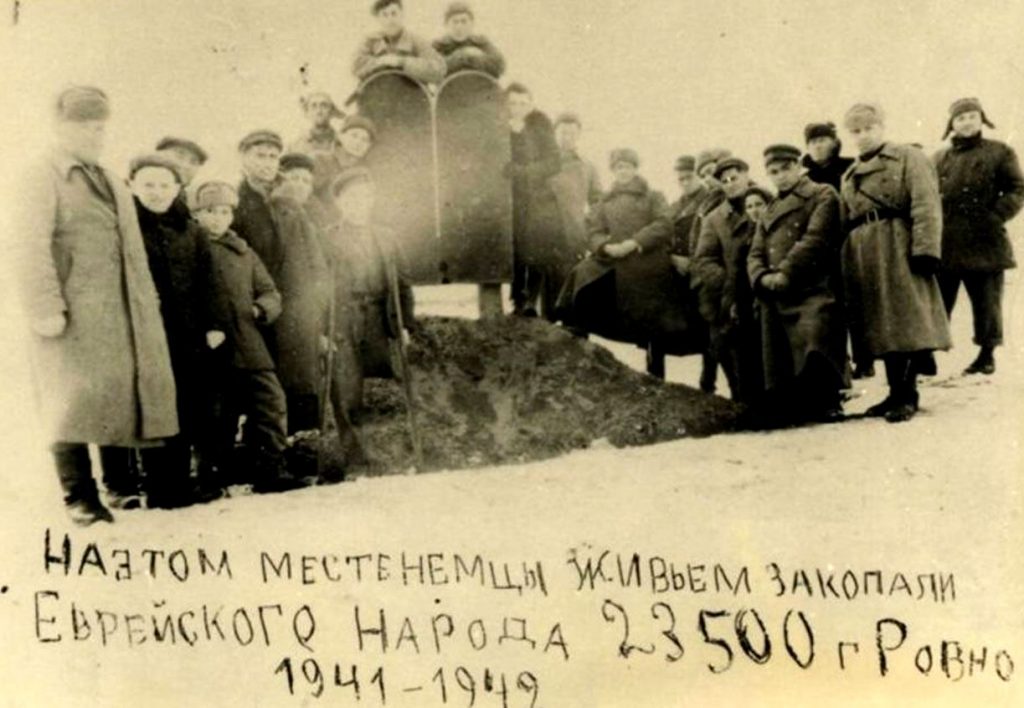
This article analyzes the perception of the Holocaust in the city of Rivne, with a special emphasis on the correlation of political forces in the region from the late 1980s to the early 1990s and the articles that were published on this topic in popular political periodicals during this period. The authors identify trends in the interpretation of the events of the Second World War by representatives of the local political elite who contributed to restoring Rivne residents' memory of the Holocaust. At the same time, their priority turned out to be the eradication of the symbols of Soviet totalitarianism and the glorification of the Ukrainian Insurgent Army (UPA). Against this background, the genocide against the Jews was a marginal storyline in the symbolic space of Rivne for a long period of time. It is only in recent years that markers recalling the Holocaust have appeared in the city. These reminder tools attest to the rejection by the local political elite of an exclusive model of collective memory.
Farewell to the Soviet experience of suppressing the Holocaust
During perestroika, the period of reformation that was introduced by [Mikhail] Gorbachev, when the national theme began to make an electrifying appearance against the backdrop of the image of the "Soviet person," which the authorities had promoted so assiduously, national minorities in Ukraine comprised 22.1 percent of the population. Taking advantage of their right to launch a renaissance, they founded numerous organizations and associations whose members participated in various forums (for example, the representatives of 1,200 organizations in the city of Rivne alone took part in the Second Assembly of National Minorities of Ukraine in 2004. [1] At the time, it was already understood that "on the outside" there were too few representatives of Otherness: According to the results of the 2001 Ukrainian census, 96 percent of the inhabitants of Rivne oblast were Ukrainians. There were only 48,000 members of national minorities in this administrative unit. At the time, .03 percent were Czechs, .04 percent Jews, and .02 percent Poles. [2]
In the city of Rivne, the oblast center, the ethnodemographic profile was practically identical. When Ukraine became a sovereign state, Ukrainians formed 91.6 percent of the population. [3].
These statistics give rise to the question of the national majority recognizing Otherness within the "parameters" of a specific administrative unit given the nearly total absence of representatives of national minorities. Who, in these conditions, is supposed to become the promoter of the memory of those who were killed or deported or who emigrated from their small fatherland? Has the historical and cultural heritage of national minorities, which became invisible long ago, ossified and should not be restored at all?
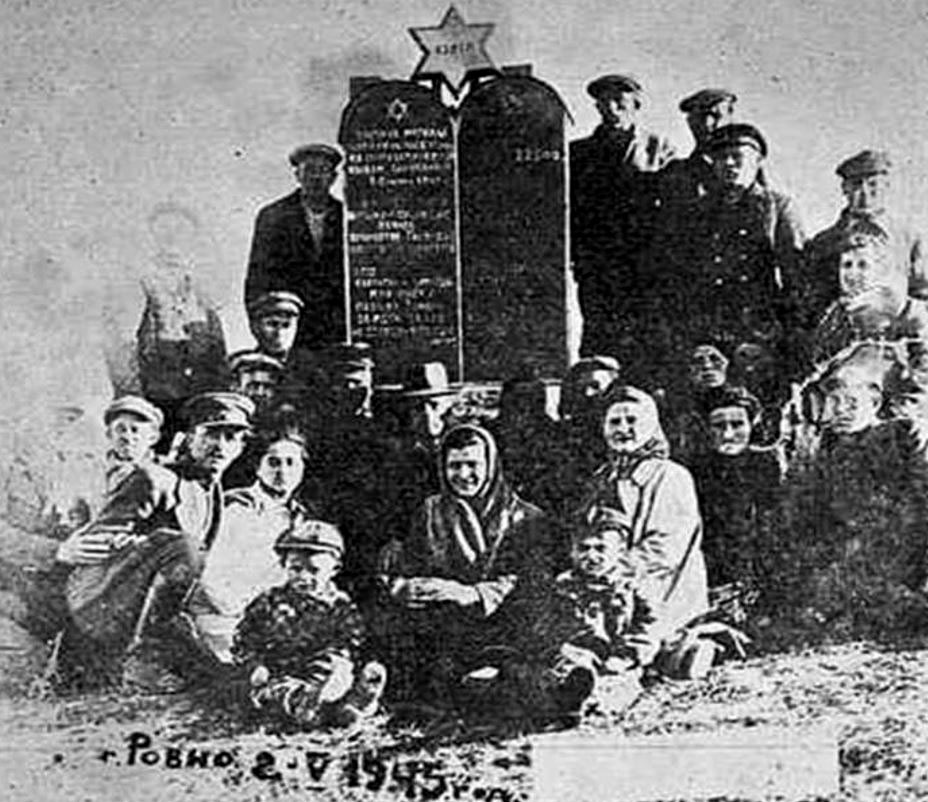
The first version of the answer to these questions was formulated from the late 1980s to the early 1990s. During this period, the perestroika years, historians sought not only to eradicate so-called "blank spots" of history, but also to eliminate the paralysis linked to evaluating the past in the Procrustean bed of "class ideals" and restore its true voice, including that which was defined by the national tuning fork.
At the time, the reinterpretation of the Second World War had an explosive effect. The public learned quite a lot about subjects that had been suppressed for decades (for example, Red Army losses in the summer of 1941, etc.). Among them was the Holocaust, which, like the Holodomor, had been taboo in the USSR for dozens of years.
One of the first manifestations of empathy for the victims of the Holocaust was the attendance by members of various nationalities (particularly Ukrainians) at events that were organized by Jews and dedicated to the memory of the victims of this genocide. One such event took place in April 1990, when the very first evening of memory was held in Rivne. [4]
Another example of Ukraine's gradual rejection of the Soviet experience of suppressing the Holocaust is the erection of memorials, commemorative markers, and the like. Ceremonies marking the unveiling of memorials, other events that aim to honor the memory of the innocent victims of Nazism, who were previously seen as the Other in western Ukraine, particularly in Rivne, are some of the components that determine the content of the inclusive model of remembrance.
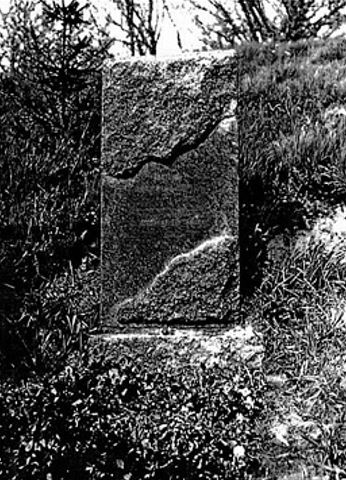
In this case, the very attendance at an event to participate in mourning is an act that speaks of respect, empathy, and memory, all of which, of course, externally reflect an individual's internal political culture. To a certain extent, the module of the latter may be generalized by the words of the poet Marianna Kiyanovska, which were heard on 20 June 2019 at a public symposium in Lviv: "I have appropriated the experience of someone else's pain."
Formation of the culture of (non)memory of the Holocaust in the late 1980s to early 1990s
In November 1990, a monument was unveiled in the Sosonky tract, where in November 1941, 17,500 Rivne Jews were shot. The event was attended by I. Fediv, head of the executive committee of the Rivne City Council of People's Deputies; S. Chornoloz, deputy head of the oblast executive committee; and V. Chervonii, People's Deputy of the Verkhovna Rada of Ukraine. [5] In June of the following year, on the eve of the 50thanniversary of the shootings of local Jews, a memorial was unveiled in the city. In addition to members of the local Jewish cultural society, the ceremony was attended by the above-mentioned head of the Rivne City Council; T. Kharchuk, deputy head of the oblast executive committee; V. Martyrosian, People's Deputy of the USSR; I. Demianiuk, member of Narodnyi Rukh Ukrainy (NRU, abbr. Rukh) and the Ukrainian Republican Party; and V. Dvorzhak, deputy head of the T. H. Shevchenko Ukrainian Language Society. [6]
In creating the memorial in Sosonky, the local government of the newly established state and the Rivne community took an important step toward including the Holocaust in the collective memory of the city residents. The reaction to the events that took place between November 1990 and June 1991 on the part of Jews in Rivne who were fortunate to have survived the Second World War is fully reflected in the words of M. Bronshtein, who lost twenty-six relatives in Sosonky: "A profound bow to all of you, countrymen, for remembering." [7]
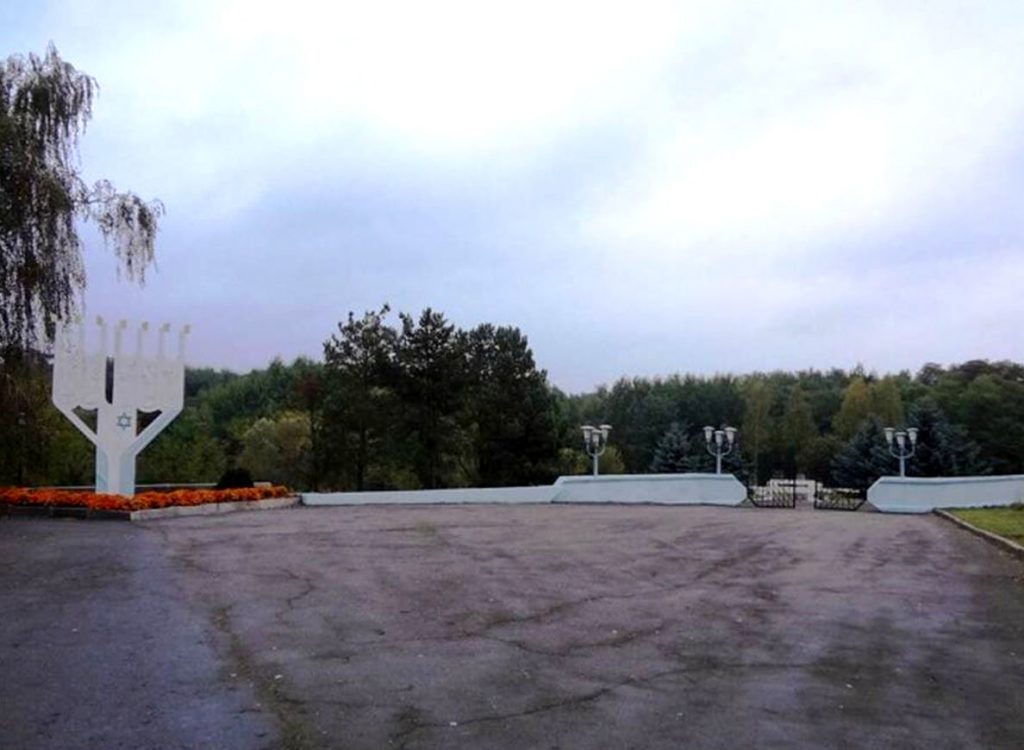
The belief that the unveiling of a memorial in Sosonky made a breakthrough in the perception of a fragment of Rivne history as another's pain, felt like one's own, is amended to a certain extent by the fact that the plan to build it originated, not in the milieu of national democratic forces, but the Soviet government, which still existed in the late 1980s. [8; 9] That said, the nuances surrounding the construction of the memorial are not determinative. The main thing is the very fact that it was erected. It was not simply that a commemorative marker had appeared in Rivne, announcing the place where a target group of victims of Nazism were executed; it also created the prerequisites for the instrumentalization of memory. Sosonky was slated to become a site for holding practices of remembrance; in the event that the memorial served as a driving force for those who would be taking part in events to honor the victims of the Holocaust, it would also speak to Ukrainians — numerically predominant in Rivne in the last few decades — about the city's non-Ukrainian past.
The unveiling of the memorial in Sosonky is not the only evidence of the course in the politics of memory on the microlevel, which was implemented after Ukraine became a sovereign state. Other evidence pointing to the rejection of Soviet-style amnesia includes articles about the killings of Jews during the Second World War in the newspaper Vilne slovo, the official organ of the Rivne oblast administration, and the dialogue between the government and the Jewish Culture Society in Rivne about the installation of markers at other sites where Holocaust victims were shot in Rivne oblast (for example, discussions were held between the fall of 1992 and spring of 1993 to create a memorial in the town of Kostopil) and their construction, most of which costs were covered by the relatives of those who were killed.
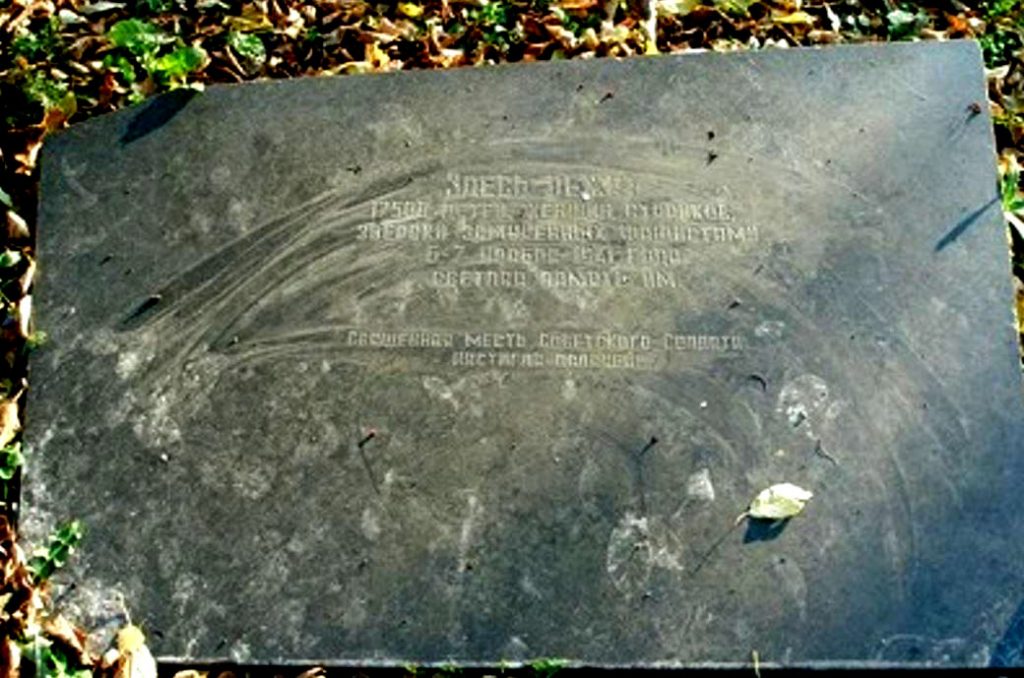
At the same time, the inclusion of the Holocaust in commemorative practice as a manifestation of the local political elite's sympathy toward the Otherness that was destroyed in Rivne proved to be deceptive. After the unveiling of the memorial in Sosonky, local government representatives occasionally avoided taking part in events held by Jewish residents. In November 1991, a local newspaper journalist reported that not a single government official or member of any political рarty was among the speakers, who included D. Feishter, the head of the Jewish Culture Society in Rivne; his secretary, O. Shteinhart, and others. The only speaker from the Ukrainian community at this event was the political prisoner I. Kotok, who remarked on the commonality of the tragic destinies of Ukrainians and Jews and called for the strengthening of their friendship in democratic Ukraine. [10]
The situation remained mostly unchanged over the next several years. For example, information published in Vilne slovo about a mourning meeting held in Sosonky in May 2000, on the anniversary of the liberation of Auschwitz, does not record the speeches of a single representative of the local or oblast authorities. Besides O. Muzychuk, the pastor of a Christian community, the speakers included H. Fraierman, the head of the Jewish Culture Society in Rivne; L. Levin, head of the Jewish War Veterans Council; P. Dunaievska, head of the Association of Former Ghetto Prisoners; and M. Aizenshtein, a member of the partisan movement. [11]
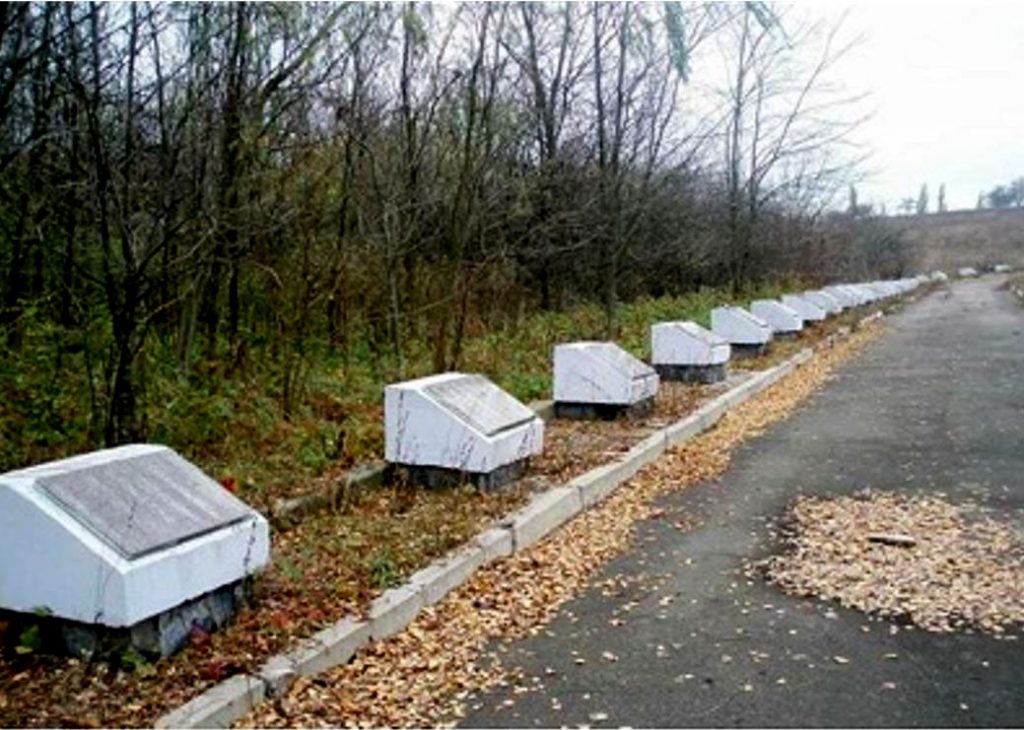
Thus, there are grounds for noting a paradoxical situation. On the one hand, the periodical press occasionally offers readers a few pages devoted to "Jewish topics," but on the other, it does not record the attendance at commemorative events of representatives of the local political elite. Here is another telling example. On the 60th anniversary of the shootings in Sosonky, the newspaper Vilne slovo limited itself to publishing a photograph of the event, yet in its regular column "Our Historical Calendar," the Nazi crime of November 1941 is not even mentioned. It is hardly likely that this (non)reflection of the events which resulted in the city losing nearly half of its inhabitants is accidental. It seems reasonable to assume that at the beginning of the twenty-first century, Otherness in Rivne began to be perceived in a new way.
This state of affairs was somewhat contradicted by articles on the "Jewish topic" in the mass media, which were published both in Rivne and various districts (for example, in the fall of 1991, the Zdolbuniv-based sociopolitical newspaper Nove zhyttia published an article about the Holocaust) [12]. The historian Yuliya Yurchuk offers a different interpretation of such articles. In her opinion, articles about the Holocaust that appear in the regional press are one of the instruments which were used by the supporters of old political values in the struggle against UPA [Ukrainian Insurgent Army — Ed.] defenders for the legacy of the Second World War. [13]
Both of these interpretations are likely correct. Moreover, the (non)presence of the Holocaust in the public discourse reflected the-then triumph of the collective unconscious, driven above all by new knowledge about the crime of the Holodomor.
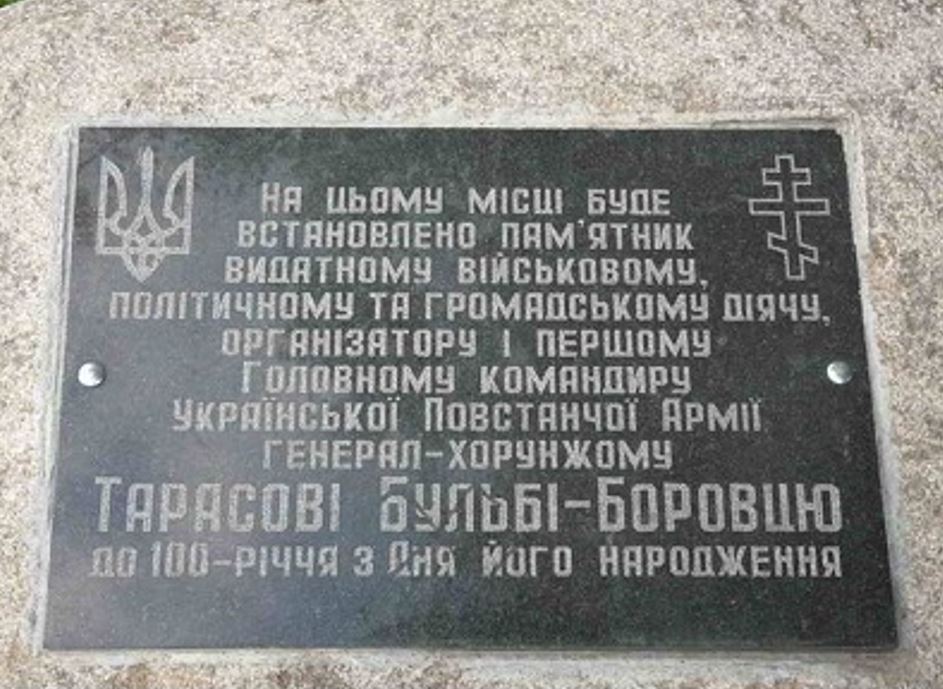
The topic of the Holodomor, which became the focus of public attention in the early twenty-first century, was reflected in the urban landscape of Rivne. On 22 November 2008, a large stone was installed on the site of a future monument to the "Victims of Holodomors and Political Repressions." [14] Considering that monuments are part of rituals, with the emergence of the first ones being a prerequisite for the installation of other ones, the project initiators' intention to use the thematic codes of the future monument to rebroadcast to Rivne residents the new assessments that were being formulated by Ukrainian historical science in those years is understandable. [15]
The "competition of victims" was attested by the distancing of a significant number of Ukrainian historians from the genocide against the Jews. This took place against the backdrop of initiatives put forward by the Ukrainian state, which led to a number of important steps toward restoring the memory of the Holocaust. Perhaps the best indicators of this were the signing of the Declaration of the Stockholm International Forum on the Holocaust (2000), the granting of permission by the Ministry of Education and Science of Ukraine to teach special courses on the history of the Holocaust in higher educational institutions, and the inclusion of this topic in the history curricula of elementary schools (1993–1994). Beginning in 2001, Ukraine's presidents began to mention Babyn Yar in their speeches. [16] Within a decade, Ukraine began to mark International Holocaust Remembrance Day on the state level.
Thus, with the unveiling of the memorial in Sosonky, the local political elite took an important step toward implementing an inclusive model of memory. Subsequently, the Holocaust topic (given the prolonged non-appearance of government officials and representatives of political parties at commemorative events and the absence of a single sign in the city marking the location of the Rivne ghetto and the Sosonky tract) was left to local Jews as their memory, not our (collective) pain.
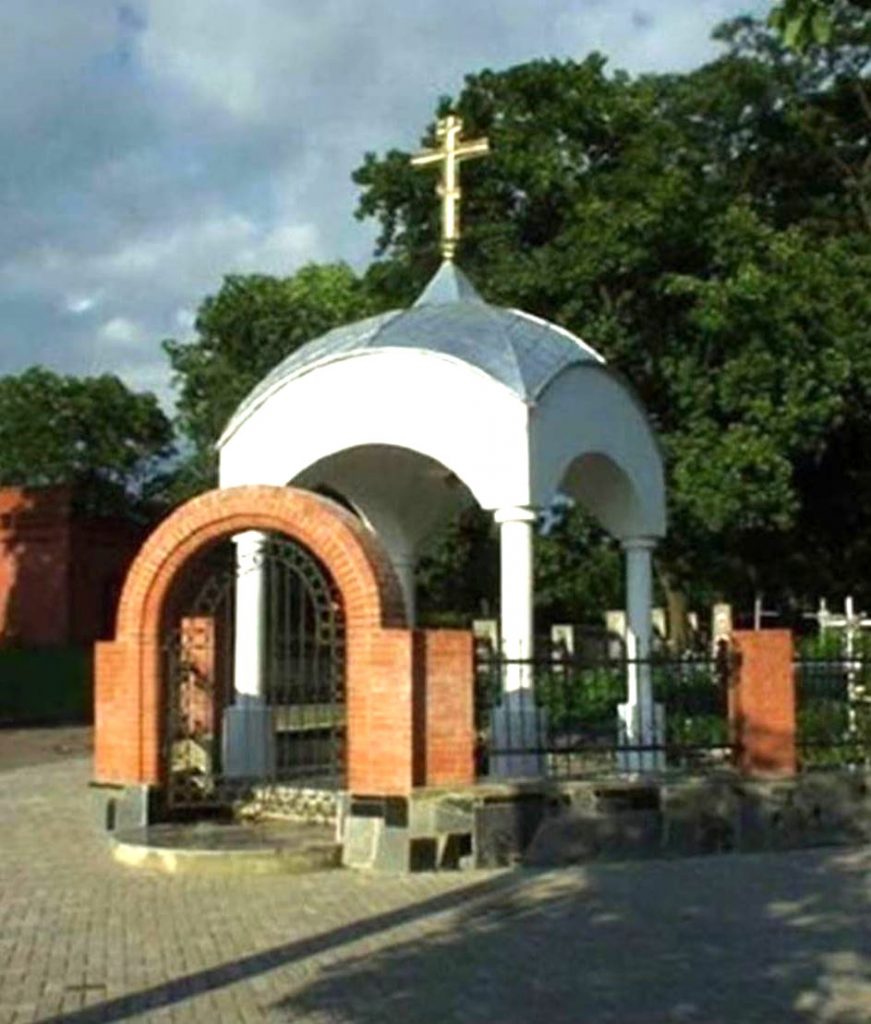
Formation of the nationalist canon of heroism and memory of the Holocaust in Rivne
This position, held by the political elite in Rivne at the time, was formed in the early 1990s. It was marked by other events that affected the change in Rivne's symbolic space: the liquidation of some monuments and hodonyms [proper names given to routes, such as the names of crossings, bridges, pathways, roads, streets, tunnels, etc. — Trans.] that referenced the Soviet past, and, at the same, the filling of the urban landscape with content referencing the UPA. Starting in the late 1980s, such transformations took place in nearly every city in western Ukraine. The changes in the region were made possible thanks to the creation of a multiparty system and the dominance of national democratic forces. As of 2 January 1994, forty-nine local branches of various political parties were registered in Rivne, 18 percent of them oblast organizations. Branches of Rukh in Rivne oblast constituted 45 percent; the Democratic Party of Ukraine (UDP) — 16 percent, the Ukrainian Radical Party — 12 percent. [17] Several years later, in 1998, leftists in Rivne were represented only by the Agrarian, Socialist, and Communist parties. Others considered themselves right-wing, centrist, or right-centrist. [18] In those years in Rivne, like in other cities in Ukraine, meetings and assemblies were a customary practice of political participation. Eventually, one city boss hatched the idea to erect a monument — next to the monument dedicated to the children of the underground [19] — to rally attendees. [20]
Rivne residents' appreciation for Rukh at the time was conditioned by the party's contribution to the struggle for Ukraine's independence in 1989–1991. Then it began to make a bid for leadership not only in the matrix of the national democratic forces in Rivne oblast but also the nationalist forces. [21] In 1998 they conducted a successful joint struggle against left-wing political forces during the run-up to the elections to the Verkhovna Rada (that year, four members of Rukh from Rivne oblast won seats). [22] They were also the main opponents in the competition for the old/new symbolic space of Rivne. The principal spokespeople of the latter in the 1990s and the initiators behind the construction of monuments were Rukh and the Ukrainian Republican Party. [23]
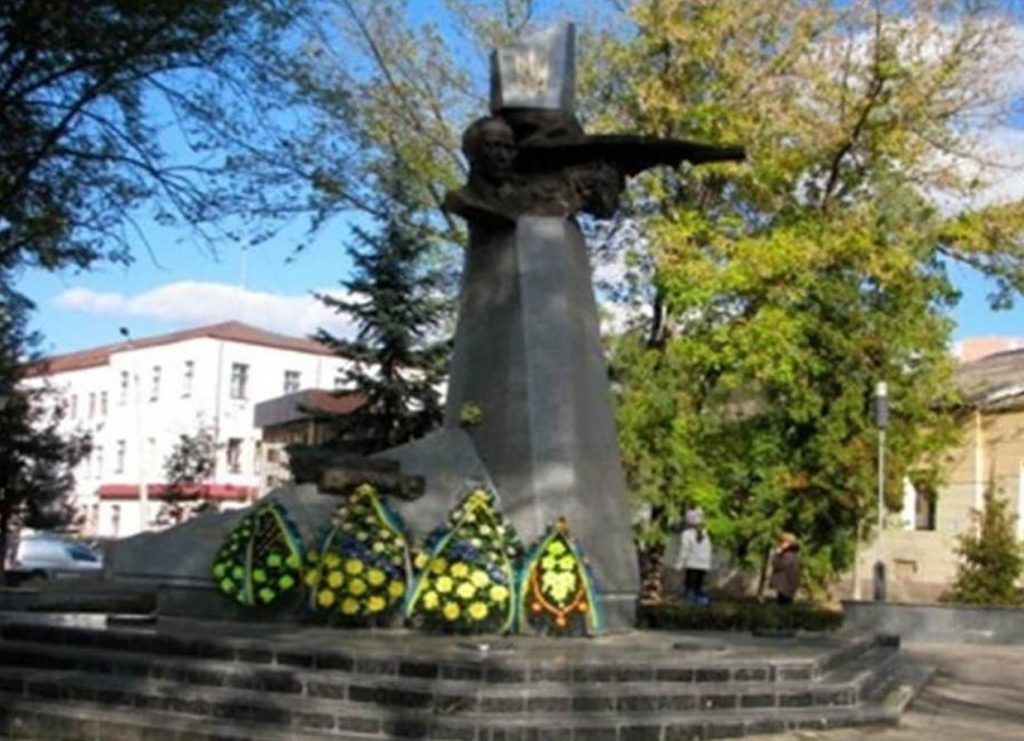
Among those who were elected to the Verkhovna Rada was Vasyl Chervonii, at the time one of the most dazzling civic and political figures in the oblast (in 1989 he founded the first Rukh center in Rivne oblast, and in 1991 he became the head of the Rivne territorial organization), and he played an important role in reformatting the symbolic landscape of Rivne. The local press commented that "in the last two years, he has been — and still is — one of the most popular figures in the civic and political life of Rivne oblast." [24]
A fresh wind of forming symbolic spaces in the cities of Galicia and Volyn began blowing in the late twentieth century, a process that was eventually called decommunization. For example, in Ivano-Frankivsk oblast, nearly fifty Soviet-era monuments and commemorative markers were dismantled by 1992. By the end of the decade, more than two hundred were dismantled. [25]
The most resonant manifestations of the rereading of the Soviet narrative and its rejection in Rivne were the dismantling of the busts of the Soviet partisan commander Dmitry Medvedev and the Soviet intelligence agent Nikolai Kuznetsov. The Rivne municipal administration's decision to dismantle the bust of the former was implemented in October 1992. [26] The following year a bigger hullabaloo erupted in connection with the dismantling of the Kuznetsov bust. In keeping with promises made by Ivan Fediv, the head of the Rivne City Council, the bust was to be dismantled on the eve of the 50th anniversary of the Nazi shootings of Rivne residents (20 October 1943), an act of reprisal for a Soviet intelligence agent's attempt to assassinate an important Nazi official of Reichskommissariat Ukraine. However, Fediv's intention was not carried out by his successor, Volodymyr Moroz. [27] The site of memory, which for decades had carried out its role fully during the Soviet era and fundamentally bound the memories of Rivne's inhabitants to the events of the war, became the subject of polemics, in which opponents of the Soviet government proposed a new reading of the activities of the Soviet underground during the Nazi occupation of Rivne. A palimpsest of the symbolic space, the start of which was launched by the local Rukh and other political forces opposed to the communists, included the task of minimizing the role of the Soviet underground (in the oblast and the entire country) and articulating the role of other forces that had taken part in the struggle against Nazism in the Ukrainian lands. On 17 May 1994, the bust of Kuznetsov was moved to Yasna, a secondary and inconspicuous street. In its place was installed a commemorative marker dedicated to "those who died for Ukraine." [28]
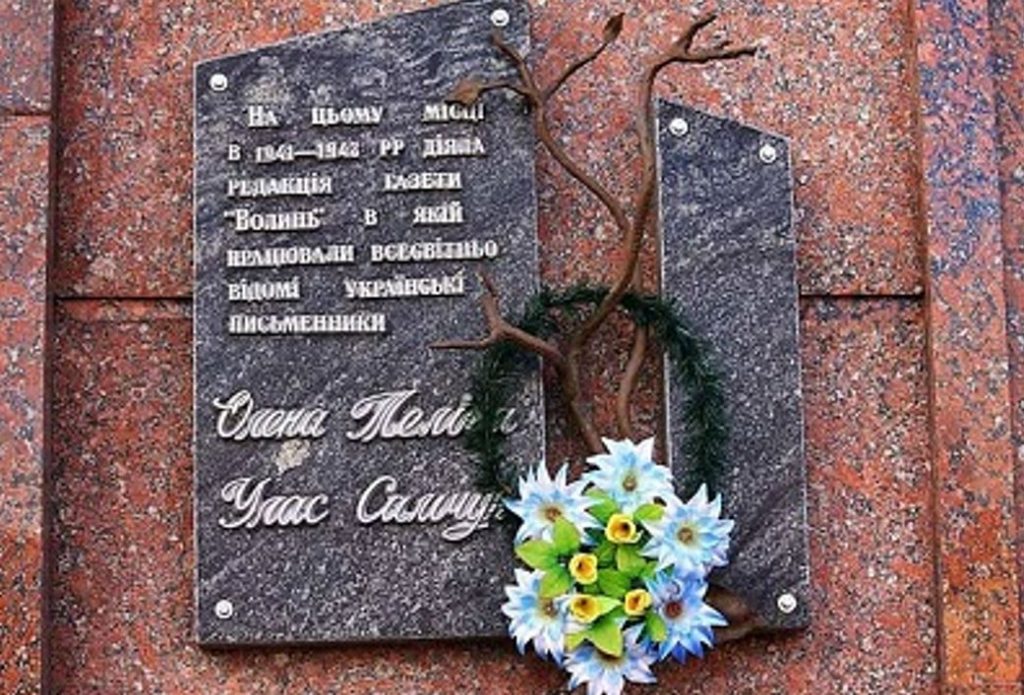
The above-described events constituted the unique preparatory stage that preceded the glorification of the UPA in the symbolic space of Rivne. It is presumed that this process began somewhat earlier, but it was implemented cautiously — and covertly in part. For example, the dismantling of the Medvedev bust took place on the 50th anniversary of the founding of the UPA. It is telling that the day before this date, 13 October 1992, a directive was circulated by the head of the Rivne City Council about renaming Volgograd, Chkalov, Vatutin, Chapaev, and other streets. These names were replaced by the surnames of various participants in the national liberation struggle during the Second World War: Nil Khasevych, Klym Savur, Yevhen Konovalets, Roman Shukhevych, and Stepan Bandera (the latter's name was supposed to replace Moskovska Street). [29] One month after the directive was issued, Mayor Fediv attended the mourning ceremonies in Sosonky — proof of the attempts of the municipal authorities to combine the process of forming its new face with the commemoration of those victims of Nazism whom the Soviet government had ignored for decades. [30]
At the same time, the above-mentioned representatives of the UPA, in whose honor streets were named in Rivne, are eloquent testimony to the fact that in the early 1990s the city fathers pursued a targeted policy of glorifying the nationalist current of the resistance movement. After the unveiling of the monument, then the memorial, in Sosonky, any version of "weaving" the Holocaust into the segment of the city's symbolic space connected to the Second World War seems not even to have been considered. It emerged as a result of the preservation of most sites of memory that had been created during the Soviet period, and it was supplemented by those that reflected the UPA's participation in the war. After completing the foreign (read: communist) initiative to tidy up the final resting place of Rivne's Jews, located in an inconspicuous spot on the city outskirts, and after holding relevant commemorative events, thus demonstrating its position on restoring the memory of the Holocaust, the local political class withdrew itself from this topic.
This hypothesis is confirmed by the fact that for decades no other steps were taken in the city to restore the memory of the people who perished in Sosonky or had been prisoners of the Rivne ghetto. After 1991, when the construction of the memorial to the victims of the Holocaust was completed, a quiet farewell was bidden to the topic of the Holocaust, the likely consequence of the extremely difficult relations between Ukrainians and Jews during the occupation, as well as of the unwillingness of the local scholarly milieu to elucidate the role that Jews played in the sociocultural and economic processes of Rivne before 1939. What also made itself felt, according to the historian Petro Dolhanov, was the fact that the city, which was "assimilated by the village after the Second World War, did not discover its own distinct identity, a circumstance that may give rise to fear of the symbols of Others, who threaten to dissolve it." [31] Indirect confirmation of the correctness of the above-mentioned hypotheses about the (un)conscious erasure of the Jewish presence in the history of Rivne is the disappearance of the information board from the building of the centrally located Great Synagogue. During the interwar period, this sacred structure was located on Shkilna Street, in the heart of Jewish Rivne. Nor were any events ever held in those years to mark Otherness in the history of Rivne, at least in the form of hodonyms. Meanwhile, the hot topics of the 1990s and the following decade continued to be the glorification of the UPA, the rejection of the Soviet past, and the discreditation of the communist current of the resistance movement (for example, in the summer of 1995, during a meeting of the Rivne Oblast Council, Vasyl Chervonii declared "that during the fascist occupation Soviet partisans barely waged a struggle against the invaders; that is why their graves are not even on the territory of Rivne oblast." [32])
As a result of the change of hodonyms and the installation of monuments, which was frequently timed to coincide with memorable UPA dates, the city's symbolic space was transformed into an arena of conflict between old and new political values. In early July 1992, supporters of the Socialist Party in Rivne protested the dismantling of the monuments to Kuznetsov and Medvedev [33]. The following year, there was a report in the press about the objection of some city residents to the renaming of some streets and about letters expressing dissatisfaction with the state of memorials glorifying the actions of Soviet soldiers in the struggle against Nazism. In 1994 the presidium of the Rivne Oblast Veterans Council sent an open letter to Mayor Moroz expressing its objection to the renaming of streets (in particular, Vatutin and Heroes of Stalingrad). [34] The list of examples indicating the rejection by some Rivne residents of the changes to the city's symbolic space (specifically those that led to the erasure of the memory of the Red Army and the Soviet partisans on the one hand, and on the other hand the glorification of the UPA) can be expanded. The culmination of the ambiguity surrounding the perception of change was the attempt to recognize Stepan Bandera as an honorary citizen of Rivne. [35] This initiative was put forward by the Svoboda Party, which submitted a proposal for consideration by the City Council in early 2011. It was supported only by deputies of the Batkivshchyna [Fatherland] Party, but there was not enough support for the resolution to be passed. Moreover, members of the City Council supported a proposal put forward by the civic organization Front for Change to revoke the Decree of the President of Ukraine "About the Awarding of the Title of Hero of Ukraine to Stepan Bandera." Members of UDAR, the Ukrainian Democratic Alliance for Reform; the People's Party; and the Party of Regions urged the Rivne City Council to draw up a relevant document. [36]
Efforts adopted in various oblasts of western Ukraine to recognize the Ukrainian Insurgent Army as well as the Organization of Ukrainian Nationalists as combatants in the Second World War played a certain role in popularizing the UPA topic. Such proposals, introduced at various levels, were also put forward in Rivne oblast, particularly during the run-up to the celebrations of the 50th and 55th anniversaries of the founding of the UPA. [37]
After the first steps were taken to change the symbolic space of Rivne (the introduction of new street names reflecting the history of the UPA), others followed: the installation of memorial plaques and the construction of a chapel. A memorial plaque dedicated to UPA Commander Taras Bulba-Borovets, the founder of the Polisian Sich, was unveiled and consecrated on 9 March 1998. [38] In 2001 a chapel was built in Hrabnyk Cemetery in honor of Klym Savur and the heroes of the national liberation struggle, 1918–1950.
These changes became possible thanks to the growing influence of political forces opposed to communism and to the work of their representatives in local self-government bodies. The preparations for marking the 60th anniversary of the UPA took place at a time when communists occupied one-fifth of the seats in the Verkhovna Rada, yet their colleagues were not represented in either the Rivne City or Oblast councils. In the meantime, the dilemmas around the creation of symbolic space in Ukrainian cities were conditioned by the range of initiatives adopted by President Leonid Kuchma, which fluctuated between the formation in 1997 of a government commission to study the activities of the OUN and the UPA and his decrees about marking the anniversaries of Ukraine's liberation from Nazi occupation, holding memorial days for the victims of Babyn Yar in 2001, and designating the Day of Partisan Glory that same year. These presidential initiatives appeared at a time when the glorification of the UPA was already taking place in Galicia, and the "war of monuments" had begun. [39]
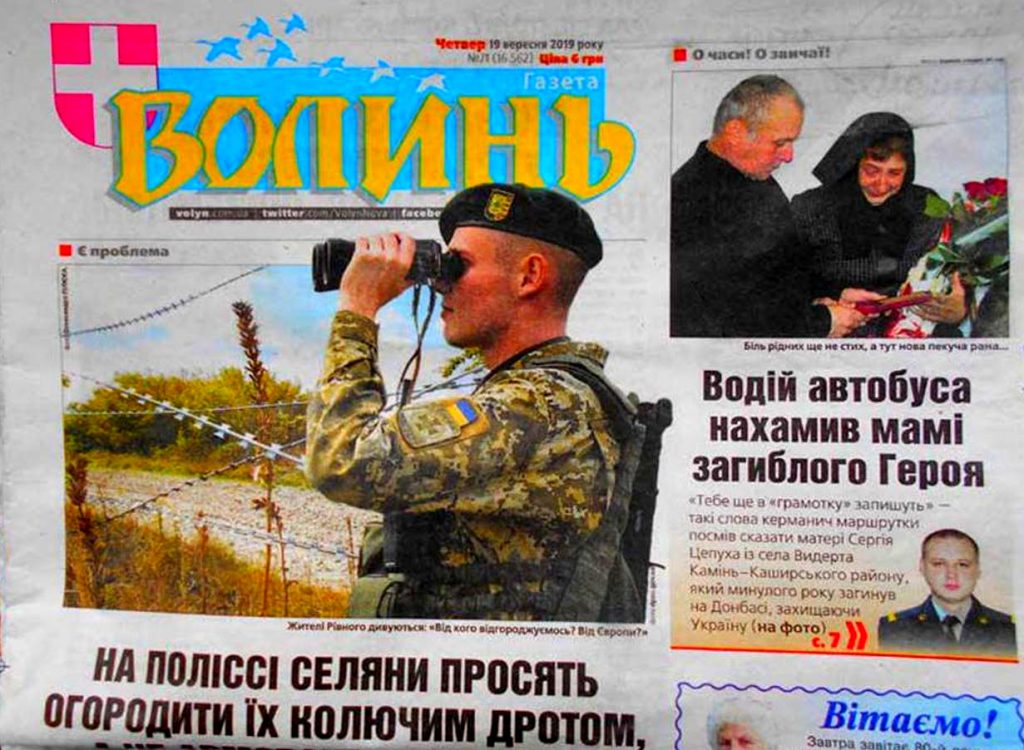
Markers of representation of the Second World War in the periodical press
Given the broad spectrum of values articulated in the decrees of the President of Ukraine and the preparations by at least some part of the national democratic forces to mark the 60th anniversary of the founding of the UPA, as well as the role of the media in the formation of public opinion or, at the very least, their popularization of one historical subject or another, it is worth analyzing the articles devoted to "history topics," which were published in Vilne slovo, the official newspaper of the Rivne Oblast State Administration in 2001 and 2002 (95 and 99 issues, respectively).
A content analysis reveals that the topic of the Second World War is important to the mouthpiece of this particular state administration. In 194 of the newspaper's issues that were published during those two years, this topic is discussed in 88 articles. At the same time, the Holocaust topic remains unchangeably marginal, and attention to events in the "Soviet canon" is decreasing. Instead, the number of articles devoted to the history of the UPA rises sharply.
Among the Others who are mentioned from time to time (to be frank, rarely) in the pages of Vilne slovo are Jews, Poles, and Germans — those who, along with Czechs, lived side by side with Ukrainians in the Volyn region. At the same time, the "Jewish topic" is represented almost exclusively in terms of the Holocaust: the events of 1941 in Sosonky, Jewish participation in the resistance movement, the unveiling of memorials in places where victims were shot on the territory of Rivne oblast, and their rescue by the Righteous Among the Nations.
In the meantime, the UPA topic was promoted much more robustly in another periodical publication: the newspaper Volyn, the mouthpiece of the Territorial Leadership of Rukh, which began publishing on 20 September 1991. This was precisely the newspaper that contributed substantially to the popularization in Rivne oblast of the Ukrainocentric model of memory. This periodical quickly outstripped its main competitor, the newspaper Chervonyi prapor, which over time became known as Vilne slovo. The print circulation of Volyn, which became the principal mouthpiece of the state idea in Rivne oblast, stood at 75,000 copies at the peak of its popularity. [40]
Presenting the past according to the principles of ethnocentrism, the newspaper did much to revive and popularize knowledge about the UPA. An article that was published to coincide with the fifth anniversary of the newspaper states the following: "Thanks to the territorial Rukh and Volyn, hundreds of gravesites of patriotic insurgents have been recovered and restored, and people have been made aware of the brilliant pages of the unequal but heroic feats of the UPA." [41]
According to its founders, Volyn was the heir to a newspaper that was published in Rivne during the Nazi occupation (1941–1943). [42] The initiators of the revived newspaper ignored the fact that strict control over sociopolitical life in the occupied territories meant that the original Volyn regularly published the ideological clichés being formulated in Berlin. The newspaper was filled with articles containing antisemitic remarks. At the same time, those who revived this periodical "failed to notice" the cooperation between the [original] editorial board and the occupier, the exaltation of the Nazi "New World Order," and the appeals to Ukrainians to go to Nazi Germany for work. The link between the current Rivne periodical and the newspaper of 50 years ago is spelled out in the newspaper's header: "Founded in 1941. Revived in 1991." Furthermore, in maintaining the adopted position of continuity, in the late 1990s, the Rivne editorial board of the Rukh newspaper, which was in conflict with the government, published an article under this headline: "Hitler shut down Volyn in 1942. Will Kuchma succeed in doing this in 1999?" [43]
Otherness in the pages of the revived Volyn, which has consistently popularized the idea of Ukraine's sovereignty, was not present until the summer of 1998, when the newspaper began reprinting Matvii Shestopal's book Ievreї v Ukraїni (Istorychna dovidka) (Jews in Ukraine: Historical Background). This dubious text, openly biased against Jews, was printed in thirty-four issues, which fact ostensibly clarifies the editorial board's position on the "Jewish question." Practically the only article on the Holocaust that was published in this newspaper was a fragment from the manuscript of Yevhen Patsula's book Volyn′ i Volyniany v Druhii svitovii viini (Volyn and Volynians in the Second World War), which the author concludes with his thoughts on the nature of "Soviet Jews." The latter do not appear before readers as the descendants of those who once formed a multicultural "microworld." On the contrary: "… denationalized Soviet Jews lived here. Divested of their language and culture, they were not schooled in the Ukrainian language and culture. Educated in the rich heritage of the third people [i.e., Russia]." [44] This interpretation of the Jews is telling. It is such that it did not allow the Rukh Volyn to perceive the lost component of the sociocultural space of the region as its "own" personal pain. In fact, it is the rejection of the Other, which suffered both from Nazism and postwar Soviet antisemitism.
It can be argued that Chervonii played a major role in the marginalization of the Other as a potential subject of Rivne's symbolic space and certainly in the promotion of the UPA's heroism. During the run-up to the 1998 election to the Verkhovna Rada, part of Rukh's platform was "National Culture: From the Sources to the Summits," by which it declared its intent to promote the development of the Ukrainian language, culture, etc., as well as to support the development of the cultures of all nationalities residing in Ukraine. [45] Meanwhile, the platform offered by Chervonii, who was running for mayor at the time, emphasized other things: the consolidation of Ukrainian national culture, the Church, Christian moral values, etc. There was no mention of the culture of national minorities or the preservation of their historical and cultural heritage. [46]
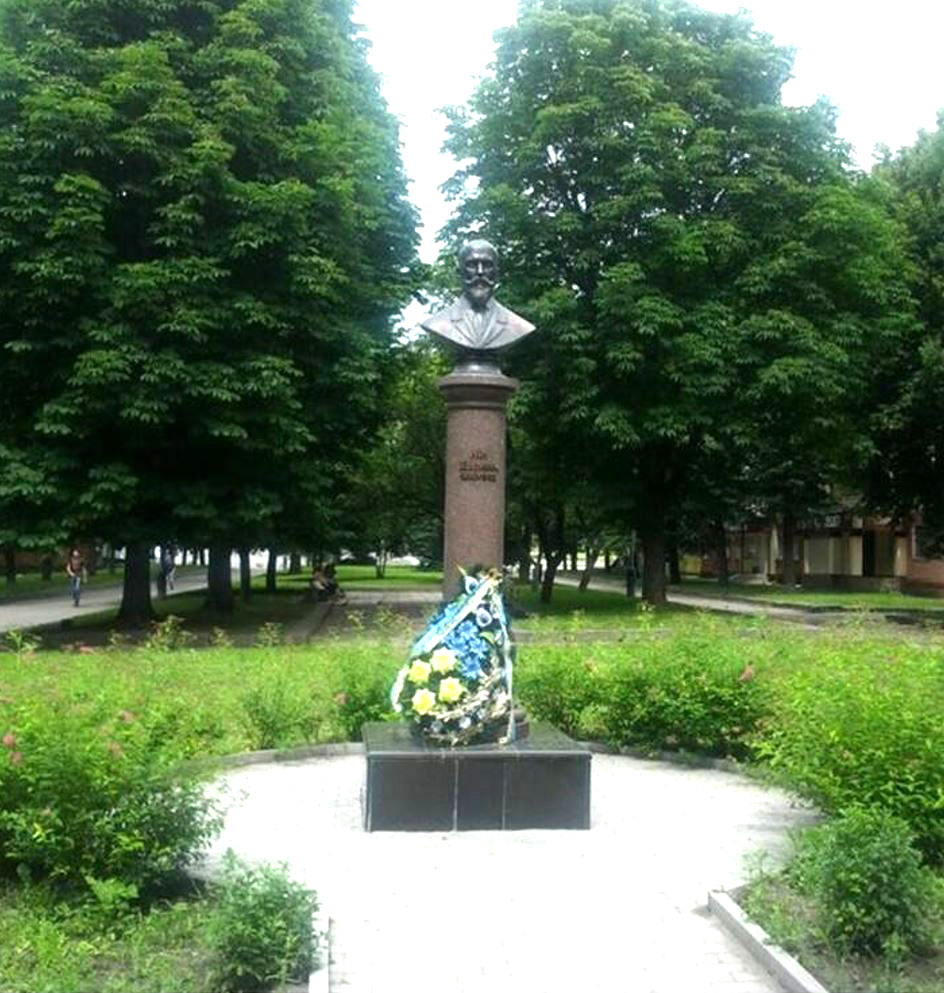
Further instrumentalization of the memory of the UPA in the city's symbolic space
The year 2002 ushered in the reframing of the symbolic space of Rivne and Rivne oblast, which was conditioned by dynamic and consistent preparations to mark the 50th anniversary of the UPA. On 13 October, a monument was unveiled in the Polisian hamlet of Hutvyn, in Kostopil raion, where the billets of the Supreme Command of the UPA were located at one time. The speakers at this event were Viktor Yushchenko, leader of the faction Nasha Ukraina (Our Ukraine); Mykola Shershun, member of the Ukrainian parliament; Oleksandr Chupryna, deputy head of the Rivne Oblast State Administration; Mykhailo Kryvko, head of the Kostopil Raion State Administration; and others. Officials also attended the unveiling on 14 October 2002 of a monument in Rivne dedicated to Klym Savur, the commander of UPA-North. As Vilne slovo reported, "representatives of the local government and People's Deputies took part in the ceremony." [47]
The year 2002 also marked the 60th anniversary of the liquidation of the Rivne ghetto. However, this memorable date did not draw the proper attention of the authorities. The latter's attendance at events dedicated to honoring UPA heroes and their snubbing of the 60th anniversary of the liquidation of the Rivne ghetto is evidence of the selective nature of commemoration and the instrumentalization of history in political activities. The 60th anniversary of the liquidation of the Rivne ghetto was ignored not only in the city of Rivne but in many other towns in Rivne oblast as well. The declared asymmetry between the marking of anniversaries is indirect proof of the Holocaust's place in local "We" memory — the silent perception of the Holocaust as a Nazi crime and support for those initiatives that contributed to restoring the memory of the nationalist current of the resistance movement.
Klym Savur is not the only figure that the local political elite sought to immortalize in monuments, thereby filling the city's symbolic space and simultaneously creating places for holding relevant commemorative events. Similar objectives were undertaken with regard to Taras Bulba-Borovets, Stepan Bandera, and Nil Khasevych, which led one local journalist to describe this sociopolitical trend as "memorial mania." [48]
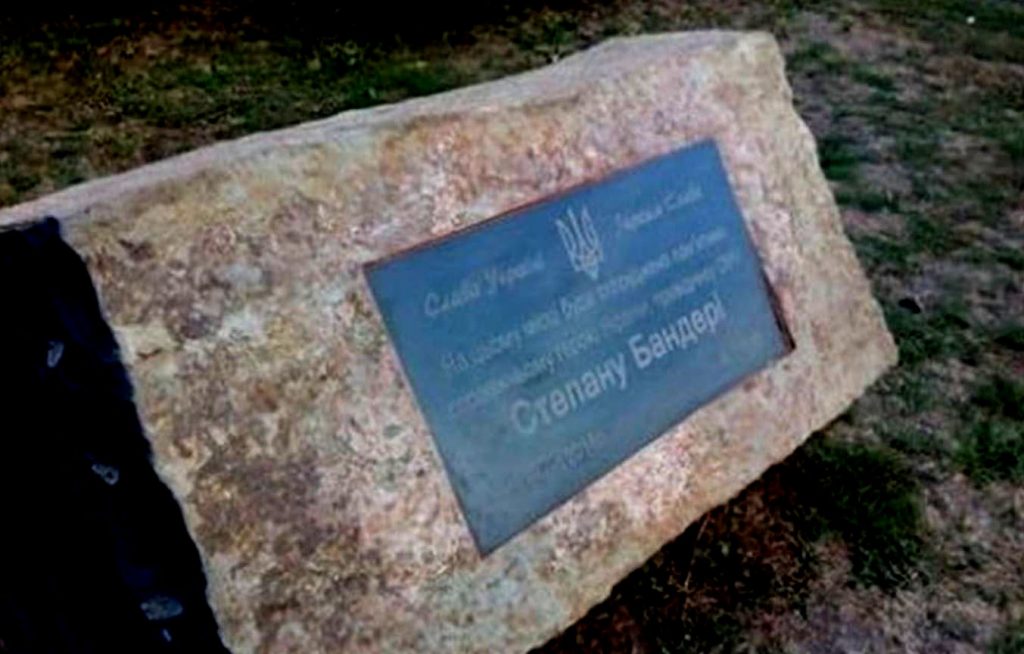
The decision to erect a monument to Bulba-Borovets was passed by the Rivne City Council in April 2003, one of several events slated to mark the centenary of his birth. To a certain extent, this decision was influenced by an appeal signed by fifteen thousand Rivne residents, which was likely organized by the Ukrainian People's Party, led by Vasyl Chervonii. [49] It proved impossible to install the monument by the designated deadline. A year later, the City Council earmarked the site of its construction, where a stone was installed in 2011 [50].
A similar marker, indicating the future installation of a monument to Stepan Bandera in Rivne, was employed in the spring of 2016. A year later, the executive committee of the Rivne City Council announced an architectural competition for submissions of the best image of Bandera. [51]
Unlike the plan to erect monuments to Bandera and Bulba-Borovets, the unveiling in October 2012 of a monument to Nil Khasevych during the celebrations of the 70th anniversary of the UPA is an actualized example of the instrumentalization of the memory of the UPA. [52] It became possible thanks to the circumstance that the bust, which was the property of the Small Academy of Personnel Management, was purchased by the Rivne City Council on the initiative of Oleksandr Kursyk, an MP from the Batkivshchyna Party. [53]
Thus, we have grounds to assert that the artistic solution of the problem of monument construction or other kinds of instruments for filling symbolic space is foreshadowed by the architectonics of local government decisions passed by a local self-government body or its structural divisions that reflect their treatment of the content of history. The role of the local political elite in defining the semantic horizons of the city's symbolic space and its instrumentalist essence, which permits the disremembering of one event or another and the contrary, the emphasizing of others, is brilliantly illustrated by the commemorative plaque that was installed by the editorial board of Volyn (2013). Those who lobbied for it ignored the realities of the occupation regime, demonstrating how amnesia functions in the mechanism of collective memory. As indicated by the text engraved on the commemorative plaque, the determining factor for the initiators of its installation was that "the world-famous Ukrainian writers Olena Teliha and Ulas Samchuk worked" at this newspaper. Making sense of Rivne's symbolic space and the place of this commemorative plaque in it, Dolhanov commented on the unveiling of this instrument of memory: "Located on Teatralna Ploshcha, the commemorative plaque, combined with the absence of any other written markers about the Holocaust on the streets of Rivne (with some exceptions, like the memorial at the Sosonky tract), attests to its amnesia with regard to the tragedy that befell the city's Jewish community during the Second World War." [54]
Thus, in recent decades the symbolic space of Rivne has been filled with markers that have balanced out the representation in the city of Soviet heroism and the activities of the UPA. Similar processes have taken place throughout Rivne oblast. The scale of the UPA's glorification is evident from the following statistics compiled by the Rivne Oblast Council: As of February 2010, this administrative region was home to 177 monuments, 310 crosses, 7 chapels, and 11 commemorative plaques. [55]
The memorial in Sosonky is not the sole marker that corrects, to some extent, the finding about the entirely Ukrainocentric discourse of that component of Rivne's symbolic space which was formed in the first decades of the twenty-first century and is connected with the events of the Second World War. Next to the monument to the executed Rivne Jews is a commemorative marker dedicated to Volynian Czechs, who fought in the Second World War. Financed and built in 2007 on the initiative of the Czechoslovak community of legionnaires, it does not play a role on par with the monuments to Soviet soldiers, victims of concentration camps, and the UPA [56].
Rukh's efforts to diminish the Soviet component in the city's symbolic space was not the only undertaking that it realized successfully. With a majority in the City Council, Rukh managed to postpone the City Day celebrations in the summer of 1998. As the press informed city residents that spring, "under pressure from the NRU fraction and the roll-call voting initiated by V. M. Chervonii, the decision passed by the Council of the previous convocation [about marking City Day on the third Sunday of May] was repealed. Rivne Day will be marked on 14 October, when Orthodox folk celebrate Pokrova [the Feast of the Protection of Our Most Holy Lady Theotokos]." However, it is clear that the issue was not just about "pegging" these events to one of the most important religious feast days, but about another aspect associated with this date: the founding of the UPA. [58]
The above leads us to state that, as of today, the war-related subjects that are reflected in Rivne's symbolic space, as well as events aimed at honoring the fallen, constituted the main and secondary components of remembrance (the heroism of the Red Army and the UPA; the Holocaust, respectively). All of them are subjects of commemorative practices, whose participants differ in terms of number and subject, of course. Given the well-attended events to honor Red Army soldiers and the UPA, it is understandable that the requiems which are organized by the tiny Jewish community of Rivne are solo performances, so to speak, ones that are almost always heard exclusively by its performers. The overall effect of such a conclusion is not altered even by the unchanging participation of former mayor Volodymyr Khomko in the ceremonies in Sosonky and by journalists' pursuit of the Holocaust topic on anniversaries of the shooting in Rivne in November 1941. This memorial continues to remain silent. Sosonky has no chance of fulfilling its function of encouraging a dialogue with visitors because there are none here, in fact. This status quo is discordant with the practice in EU countries, where the genocide of the Jews during the Second World War is an essential marker for understanding the crimes of totalitarianism.
Conclusions
Shunted to the margins of Rivne's symbolic space, Otherness acquired somewhat of a new voice in the last two years, thanks to the installation of Stolpersteine (stumbling blocks), markers that commemorate the victims of the Rivne ghetto, and to the installation of street markers about the history of this erstwhile multicultural city. The first ones (like the above-mentioned marker, located at the intersection of Soborna and Doroshenko streets), which immortalize the victims of Nazism of Ukrainian, Polish, and Jewish nationalities, appeared in Rivne thanks to the efforts of the NGO Мnemonics, the Center for Studies of Memory Policy and Public History. These markers (including the one indicating the location of Sosonky) are the result of a project undertaken by the civic activist M. Balyka, who in 2016 won a public budget competition organized by the Rivne City Council. Basically, both initiatives were supported by city officials, a good example of understanding Otherness, not as a threat or a challenge, but as the representation in the urban space (streets) of the sociocultural uniqueness of our former neighbors, who faded into obscurity during the Second World War. At the same time, the position of Rivne mayor Khomko and relevant City Council committees, which, in one case, did not hinder the implementation of the NGO's initiative, and in another contributed to the realization of a project carried out by a local NGO, is an indicator of their important role in determining the components of the mosaic (especially ethnoconfessional) of symbolic space
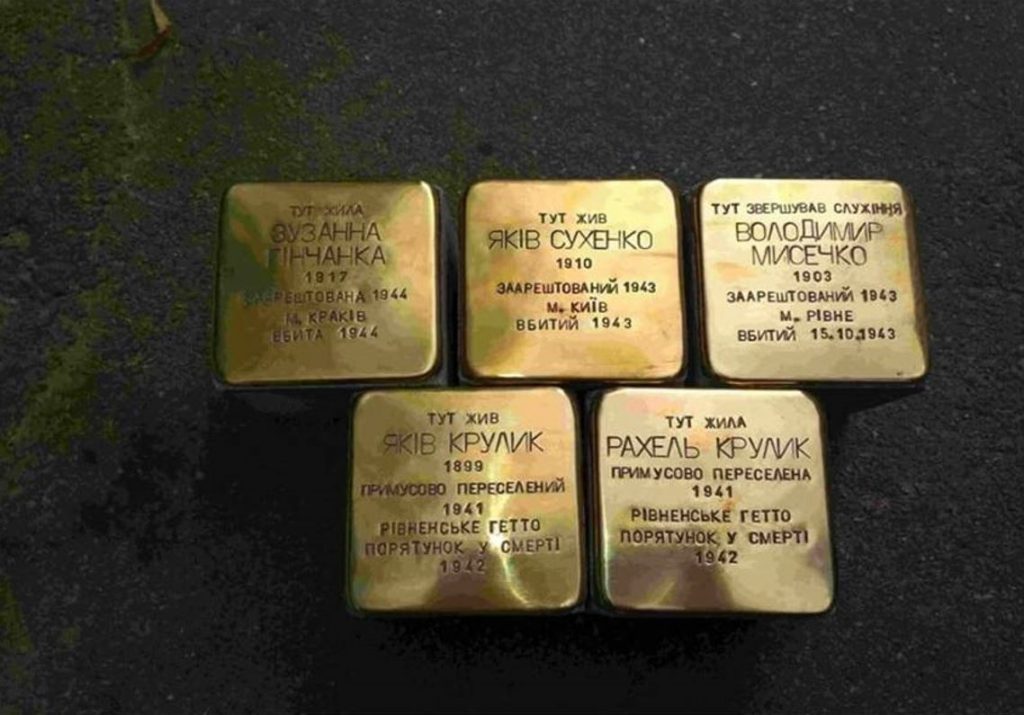
Thus, in the last several decades, the political elite of Rivne demonstrated an inconsistency in its perception of the city's sociocultural heritage. Its non-Ukrainian representatives disappeared both in this city and in the entire region during the Second World War, and during the postwar years, the Soviet authorities filled the city with symbols that corresponded to a treatment of heroism and suffering that was acceptable to them. Otherness as a method of emphasizing social groups and their representation in society ended up outside this artificially created construct.
By virtue of the unveiling of the memorial to the victims of the Holocaust in Rivne, its symbolic space was augmented by a marker that spoke about the city's "Jewish past." At the same time, the rejection of its silencing did not signify the political elite's genuine readiness to apprehend Otherness. In instrumentalizing memory, it did away with a considerable number of hodonyms and monuments recalling the Red Army and Soviet partisans who had fought in the German–Soviet war, while concurrently glorifying the UPA. This was a kind of an end in itself for a segment of the national democratic forces. Substantially represented in city councils and enjoying the support of residents, it reconsidered Rivne's symbolic space (especially the component that recalled the Second World War). At the same time, the Other and its sociocultural heritage were marginalized, a circumstance attested by the eschewal of marking the Polish component in the urban landscape. This practice was amended only in recent years, when, thanks to initiatives put forward by local activists, which gained the support of government officials, some instruments of remembrance appeared in Rivne, recalling the city's former multiculturalism and coexistence between the representatives of various nationalities.
Maksym Hon and Nataliia Ivchyk
This text is an abbreviated version of an article first published in 2020 in the Ideology and Politics Journal, № 2 (16), pp. 229–50.
This article features photographs from the private archives of Maksym Hon and Nataliia Ivchyk, as well as from open sources.
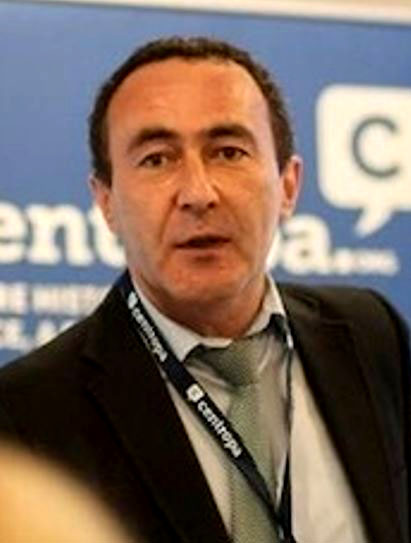 Мaksym Hon is a historian and the director of the civic organization Mnemonics. His research interests include the politics of memory, ethnopolitical processes, and genocides in history. In 1998 he defended his dissertation for the degree of Candidate of Political Science entitled "The Activities of Jewish Political Parties in Western Ukraine in the Context of Ukrainian-Jewish Relations (1918–1929)." In 2007 he obtained the degree of Doctor of Political Science (the title of his dissertation is "Inter-ethnic Interaction in the Western Ukrainian Lands during the Interwar Period").
Мaksym Hon is a historian and the director of the civic organization Mnemonics. His research interests include the politics of memory, ethnopolitical processes, and genocides in history. In 1998 he defended his dissertation for the degree of Candidate of Political Science entitled "The Activities of Jewish Political Parties in Western Ukraine in the Context of Ukrainian-Jewish Relations (1918–1929)." In 2007 he obtained the degree of Doctor of Political Science (the title of his dissertation is "Inter-ethnic Interaction in the Western Ukrainian Lands during the Interwar Period").
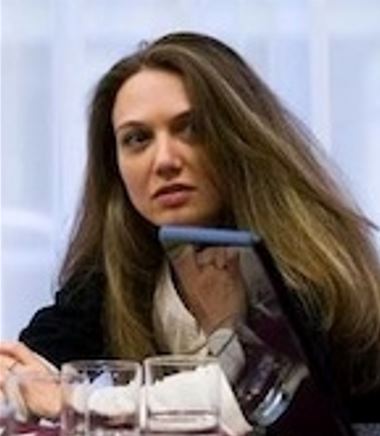 Nataliia Ivchyk is a historian and administrative head of the civic organization Mnemonics. Her research interests include the politics of memory, ethnopolitical processes, genocides in history, and women's history. In 2012 she defended her dissertation for the degree of Candidate of Historical Sciences entitled "The Polish and Jewish Questions in Tsarist Policies in Right-Bank Ukraine (Second Half of the 1850s–Early 1880s)."
Nataliia Ivchyk is a historian and administrative head of the civic organization Mnemonics. Her research interests include the politics of memory, ethnopolitical processes, genocides in history, and women's history. In 2012 she defended her dissertation for the degree of Candidate of Historical Sciences entitled "The Polish and Jewish Questions in Tsarist Policies in Right-Bank Ukraine (Second Half of the 1850s–Early 1880s)."
[1] "Shchob Ukraїna bula dlia vsikh matir'iu," Vil′ne slovo, 27 October 2004 (№ 81), p. 1.
[2] Zoia Androshchuk, "Natsional′nyi sklad naselennia Rivnens′koї oblasti ta ioho movni oznaky," Vil′ne slovo, 26 December 2003 (№ 101), p. 14; Volodymyr Komarovs′kyi, "Ukraїntsiv na Rivnenshchyni ponad 96 vidsotkiv," Vil′ne slovo, 11 April 2003 (№ 28), p. 2.
[3] Yuliya Yurchuk, Reordering of Meaningful Worlds: Memory of the Organization of Ukrainian Nationalists and the Ukrainian Insurgent Army in Post-Soviet Ukraine (Stockholm: Stockholm University, 2014), p. 58.
[4] D. Feishter, "Pam’iati shesty mil′ioniv," Chervonyi prapor, 29 May 1990 (№ 104), p. 1.
[5] D. Feishter, "Svichky skorboty — svichky nadiї," Chervonyi prapor, 14 November 1990 (№ 216), pp. 1, 4.
[6] Ie. Shepit′ko, "Sosonky, 1941–1991…" Chervonyi prapor, 26 June 1991 (№ 121), p. 2.
[7] M. Bronshtein, "Za pam’iat′--velyke spasybi," Chervonyi prapor, 14 November 1990 (№ 216), p. 2.
[8] Mis′kvykonkom, arkhivnyi viddil (hereafter cited as Municipal Executive Committee, Archives Division), f. 201, op. 1, spr. 24, ark. 48, 50.
[9] Municipal Executive Committee, Archives Division, f. 201, op. 1, spr. 24, ark. 88.
[10] A. Fedorov, "Azkara," Chervonyi prapor, 5 November 1991 (№ 183), p. 2.
[11] Kim Zakaliuk, "Kholokost — zhyvtsem spaleni," Vil′ne slovo, 26 May 2000 (№ 40), p. 2.
[12] O. Lahodzins′kyi, "Za zakonamy liudianosti," Nove zhyttia, 30 November 1991 (№ 140), p. 3.
[13] Yurchuk, Reordering, p. 99.
[14] "U Rivnomu rozpochaly budivnytstvo pam’iatnyka ‘Zhertvam holodomoriv ta politychnykh represii," https://zaxid.net/u_rivnomu_rozpochali_budivnitstvo_pamrzquoyatnika_quotzhertvam_golodomoriv_ta_politichnih_represiyquot_n1065579/amp.
[15] Yurchuk, Reordering, p. 30.
[16] Ivan-Pavlo Khymka [John-Paul Himka], "Retseptsiia Holokostu v postkomunistychnii Ukraїni," Ukraїna moderna, https://uamoderna.com/md/223-223.
[17] Vil′ne slovo, 23 April 1994 (№ 31), p. 1.
[18] Bohdan Hrynchuk, "Zakonomirni naslidky nadlyshkovoї demokratyzatsiї," Volyn′, 15 May 1998 (№ 20), p. 3.
[19] This was probably an attempt to honor the heroes of Vladimir Korolenko's novel Children of the Underground.
[20] "U Rivnomu planuiut′ vidkryty pam’iatnyky mitynhuval′nyku ta ditiam pidzemellia," Rivnens′kyi reporter, 4 January 2012 (№ 1), p. 2.
[21] "Pro hromads′ko-politychni і relihiini vidnosyny v oblasti," Vil′ne slovo, 27 December 1997 (№ 99–100), p. 2.
[22] I. Dem'ianiuk, "Pro suspil′no-politychne stanovyshche na Rivnenshchyni v 1998 rotsi; Pidsumky roku," Vil′ne slovo, 22 January 1999 (№ 7), p. 2.
[23] Yurchuk, Reordering, p. 89.
[24] "Poterpymo do vesny," Chervonyi prapor, 15 November 1991 (№ 188), p. 1.
[25] Tetiana Fedokova and Liudmyla Oleniuk, "Osoblyvosti natsional′noї dekomunizatsiї: Iak pozbuvaiut′sia radians′kykh symvoliv na zakhodi ta skhodi kraїny," Halyts′kyi korespondent, 2 June 2019, https://gk-press.if.ua/osoblyvosti-natsionalnoyi-dekomunizatsiyi-yak-pozbuvayutsya-radyanskyh-symvoliv-na-zahodi-shodi-krayiny/?fbclid=IwAR3ZjPjUqfn8SrHos_u1JODbLevn6i5UVYTAVljCg5OOwGoZMfKFVTOQCok.
[26] A. Artyniuk, "Viina z pam’iatnykamy perekhodyt′ u pidpillia," Vil′ne slovo, 24 October 1992 (№ 103), p. 1.
[27] M. Rokytynets′, "Shche odyn mitynh," Vil′ne slovo, 20 October 1993 (№ 80), p. 1.
[28] "Pam’iatnyk zahyblym za Ukraїnu," https://uk.wikipedia.org/wiki/%D0%A4%D0%B0%D0%B9%D0%BB:%D0%9F%D0%B0%D0%BC%E2%80%99%D1%8F%D1%82%D0%BD%D0%B8%D0%BA_%D0%B7%D0%B0%D0%B3%D0%B8%D0%B1%D0%BB%D0%B8%D0%BC_%D0%B7%D0%B0_%D0%A3%D0%BA%D1%80%D0%B0%D1%97%D0%BD%D1%83_%D0%A0%D1%96%D0%B2%D0%BD%D0%B5.jpg.
[29] V. Herus, "Stari vulytsi z novymy nazvamy," Vil′ne slovo, 17 October 1992 (№ 101), p. 1.
[30] F. Dumov, "Nezahoina rana," Vil′ne slovo, 28 November 1992 (№ 113), p. 1.
[31] M. Hon, P. Dolhanov, and N. Ivchyk, Мisto pam'iati — misto zabuttia: Palimpsesty memorial′noho landshaftu Rivnoho (Rivne: Volyns′ki oberehy, 2017), p. 155.
[32] Andrii Hrechko, "Ni, pane Chervonii, tse nasha istoriia," Vil′ne slovo, 4 March 1995 (№ 18), p. 1.
[33] O. Stratiuk, "Aktsiia protestu," Vil′ne slovo, 4 July 1992 (№ 71), p. 1.
[34] "Vidkrytyi lyst," Vil′ne slovo, 6 April 1994 (№ 26), p. 2.
[35] By this time Bandera had already been granted the title of honorary citizen of Lviv, Lutsk, Ternopil, Ivano-Frankivsk, Dolyna, Terebovlia, Truskavets, Chervonohrad, and Khust.
[36] Viktoriia Levchuk, "Banderu ne vyznaly pochesnym hromadianynom Rivnoho," Rivnens′kyi reporter, 26 January 2011 (№ 4), p. 1.
[37] "Ishly za voliu u vii," Vilne slovo, 17 October 1992 (№ 101), p. 2; "Sesiia oblasnoї rady," Vil′ne slovo, 8 March 1997 (№ 19), p. 1.
[38] Hurii Bukhalo, "Rivnenshchyna vidznachyla 90-richnyi iuvilei Tarasa Bul′by-Borovtsia," Volyn′, 13 March 1998 (№ 11), p. 2.
[39] O. A. Hrytsenko, Prezydenty і pam’iat′: Polityka pam’iati Prezydentiv Ukraїny (1994–2014); Pidgruntia, poslannia, realizatsiia, rezul′taty (Kyiv: "K.I.S.," 2017), p. 117.
[40] Serhii Stepanyshyn, "Rovesnytsia nezalezhnoї Ukraїny," Volyn′, 20 September 1996 (№ 38), p. 1.
[41] Ibid., p. 2.
[42] "Poterpymo do vesny," p. 1; Stepanyshyn, "Rovesnytsia," p. 1.
[43] "Hitler zakryv Volyn′ u 1942 rotsi? Chy vdast′sia tse Kuchmi v 1999-mu?" Volyn′, 23 April 1999 (№ 4), p. 1.
[44] Iosyp Patsula, "Ukraїns′ki ievreї chy ievreї z Ukraїny," Volyn′, 11 May 1999 (№ 11), p. С. 6.
[45] "Novyi shliakh Ukraїny: Vyborcha prohrama Rukhu Ukraїny," Volyn′, 9 January 1998 (№ 2), p. 10.
[46] "Kandydat na posadu mis′koho holovy m. Rivne Chervonii Vasyl′ Mykhailovych: Vyborcha prohrama," Volyn′, 15 March 1998 (№ 11), p. 4.
[47] M. Fomenko, "Podvyhy UPA uvichniuiut′ pam’iatnyky," Vil′ne slovo, 16 October 2002 (№ 79), p. 1.
[48] Ihor Hoshovs′kyi, "Pam’iatnyky natsional′nym heroiam — vizytka Rivnoho v sviti," Volyn′, 15 July 2005 (№ 28), p. 2.
[49] Hurii Bukhalo, "UPA v bronzi," Volyn′, 7 October 2005 (№ 40), p. 19.
[50] Hon, Dolhanov, and Ivchyk, Мisto pam’iati, pp. 97–98.
[51] "U Rivnomu z’iavyt′sia pam’iatnyk Stepanu Banderi?" https://rivne1.tv/news/91169.
[52] U Rivnomu vidkryto pam’iatnyk khudozhnyku UPA," https://ukranews.com/ua/news/163624-u-rivnomu-vidkryto-pam-yatnyk-khudozhnyku-upa.
[53] "Patrioty vsi, poky ne dokhodyt′ do dila," 7 dniv, 25 October 2012 (№ 44), p. 2.
[54] Hon, Dolhanov, and Ivchyk, Мisto pam’iati, p. 77.
[55] "Rishennia [Rivnens′koї] oblasnoї rady 5-ho sklykannia," https://ror.gov.ua/rishennya-oblasnoyi-radi-5-sklikannya.
[56] V. Trofaniuk, "Pam’iatnyi znak Volyns′kym chekham vidkryly v Rivnomu," in V. Trofaniuk, Kvasyliv: Frahmenty istoriї, vol. 1, comp. A. Lymych (Voinarovych) (Rivne: Volyns′ki oberehy, 2011), pp. 182–83.
[57] Valentyna Myakovs′ka, "Konfrontatsiia — dilu ne pidmoha," Vil′ne slovo, 2 May 1998 (№ 37), p. 1.
[58] A few years later, the members of the City Council refused to mark City Day on 14 October.
The authors are solely responsible for the accuracy of all content, including citations.
Originally appeared in Ukrainian @Ukraina Moderna
This article was published as part of a project supported by the Canadian non-profit charitable organization Ukrainian Jewish Encounter.
Translated from the Ukrainian by Marta D. Olynyk.
Edited by Peter Bejger.
NOTE: UJE does not necessarily endorse opinions expressed in articles and other materials published on its website and social media pages. Such materials are posted to promote discussion related to Ukrainian-Jewish interactions and relations. The website and social media pages will be places of information that reflect varied viewpoints.



















